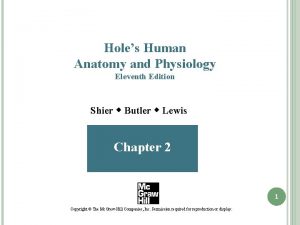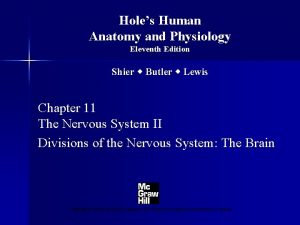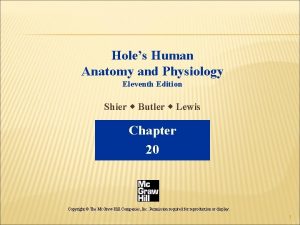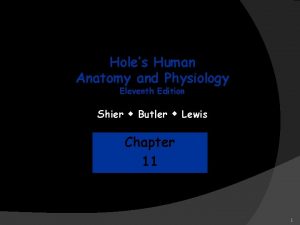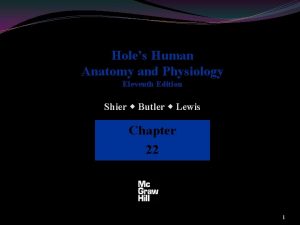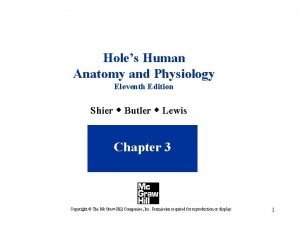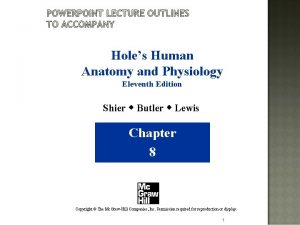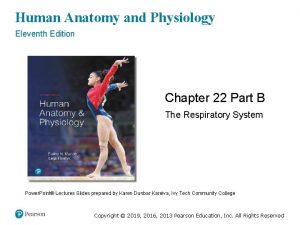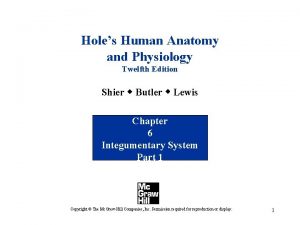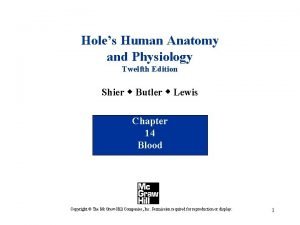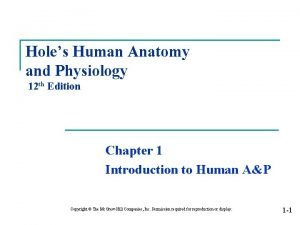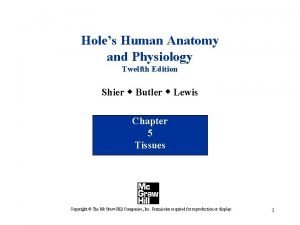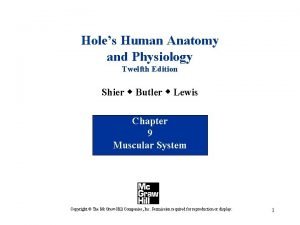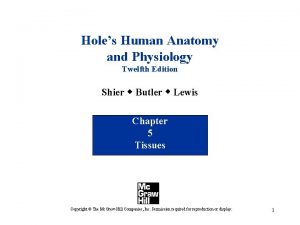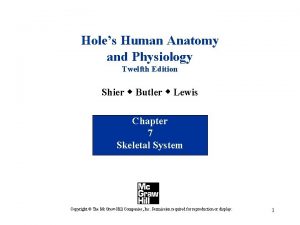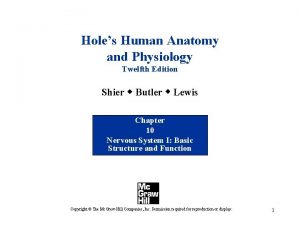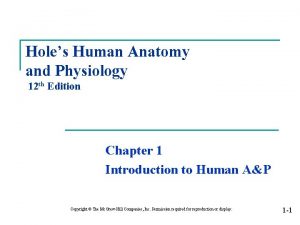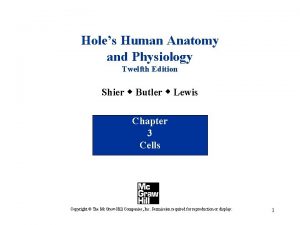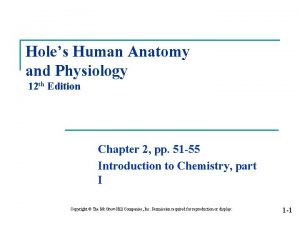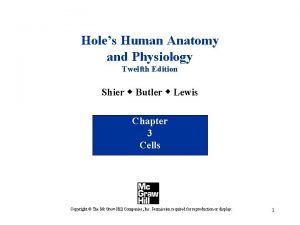Holes Human Anatomy and Physiology 1 Eleventh Edition






































- Slides: 38

Hole’s Human Anatomy and Physiology 1 Eleventh Edition Shier w Butler w Lewis CHAPTER 1 Copyright © The Mc. Graw-Hill Companies, Inc. Permission required for reproduction or display.

Chapter 1 Introduction to Human Anatomy and Physiology 2 Stone Age: • 30, 000 year old cave paintings show simple anatomy of humans and other animals • interest in body

Classical Period: 3 • 5 th century BC Greece 1 st recorded study of anatomy • Most cultures had strong religious restrictions on study of the human body (Chinese, Egyptians, Hindus, etc…) • Early study concerned with treating illnesses and injuries

Classical Period Cont…. . 4 Hippocrates (460 -377 BC) “Father of Medicine” oath that medical school graduates take named for him (Hippocratic Oath) Aristotle (384 -322 BC) – animal dissections Errors in his theories such as he believed the blood vessels only contained air Herophilus (335 -280 BC) & Erasistratus (310 -250 BC) 1 st recorded human dissections Galen (2 nd century AD) – organized books of Greek medical discoveries – only ones that survived the Dark Ages.

Dark Ages: 476 -1000 AD 5 Severe illness blamed on the Devil or divine retribution for sin thus cure was obedience to God Often turned to herbalists Physicians used leeches, ground coral, roasted mice & bats blood

Middle Ages: 5 th -16 th century Renaissance: 14 th-17 th 6 century Renewal in interest of human body and medicine Leonardo da Vinci (1452 -1519) – anatomical drawings Andreas Vesalius (1514 -1564) – published text with drawings from dissections – “Father of Anatomy”

7 Until the Anatomy Act of 1832 18 th & 19 th century the only legal means of obtaining a cadaver for dissection was condemned criminals Before this time Body –snatchers (also called resurrectionists) often used to help supply cadavers for medical students (Burk and Hare story)

Levels of Organization 8 Subatomic Particles – electrons, protons, neutrons Atom – hydrogen atom, lithium atom Molecule – water molecule, glucose molecule Macromolecule – protein molecule, DNA molecule Organelle – mitochondrion, Golgi apparatus, nucleus Cell – muscle cell, nerve cell Tissue – simple squamous epithelium, loose connective tissue Organ – skin, femur, heart, kidney Organ System – skeletal system, digestive system Organism - human

Levels of Organization 9

Anatomy and Physiology 10 Anatomy – study of structure (Greek – “a cutting up”) Physiology – study of function (Greek – “relationship to nature”) Structure is always related to function

Clinical Application Medical 11 Imaging • Noninvasive procedures • Provide images of soft internal structures Ultrasonography • Use of highfrequency sound waves • Relatively quick and inexpensive Magnetic Resonance Imaging • Requires injection of dye • Produces computerized images from different angles

Characteristics of Life 12 Movement – change in position; motion Responsiveness – reaction to a change Growth – increase in body size; no change in shape Reproduction – production of new organisms and new cells Respiration – obtaining oxygen; removing carbon dioxide; releasing energy from foods

Characteristics of Life 13 Digestion – breakdown of food substances into simpler forms Absorption – passage of substances through membranes and into body fluids Circulation – movement of substances in body fluids Assimilation – changing of absorbed substances into chemically different forms Excretion – removal of wastes produced by metabolic reactions All together these events are considered meabolism.

Requirements of Organisms 14 Life depends on five environmental factors • water • food • oxygen • heat • pressure

Requirements of Organisms 15 Water - most abundant substance in body - required for metabolic processes - required for transport of substances - regulates body temperature Food - provides necessary nutrients - supplies energy - supplies raw materials

Requirements of Organisms 16 Oxygen (Gas) - one-fifth of air - used to release energy from nutrients Heat - form of energy - partly controls rate of metabolic reactions Pressure - application of force on an object - atmospheric pressure – important for breathing - hydrostatic pressure – keeps blood flowing

Homeostasis 17 Homeostatic Mechanisms – monitor aspects of the internal environment and corrects any changes • Receptors - provide information about stimuli • Control center - tells what a particular value should be (includes a set point) • Effectors - elicit responses that change conditions in the internal environment

Homeostatic Mechanisms 18

Homeostatic Mechanisms 19 Negative Feedback System – drives conditions back toward the normal Positive Feedback System – drives conditions away from the normal

Body Cavities 20

21

Body Membranes 22 Mucous membrane - Lines tubes and body cavities that open to the outside of the body Serous membrane – Lines a cavity without an opening to the outside of the body

Serous Membranes 23 Visceral layer – covers an organ Parietal layer – lines a cavity or body wall Thoracic Membranes • Visceral pleura • Parietal pleura • Visceral pericardium • Parietal pericardium Plura = lungs Pericardium = heart Abdominopelvic Membranes • Visceral peritoneum • Parietal peritoneum

Serous Membranes 24

Serous Membranes 25

Body Coverings 26 Skin, hair, nails, oil & sweat glands Protection Regulate body temp. Vitamin D synthesis

Support & Movement 27 Muscular Movement Heat Skeletal Support Protection Blood cell production

Integration & Coordination 28 Endocrine – glands Uses chemical messages called hormones for communication Nervous System – brain, spinal cord, nerves, & sense organs Uses electrical impulses for comunication

Transport 29 Cardiovascular Heart, arteries, veins, capillaries, & blood Transports nutrients, waste products, & hormones Lymphatic Lymph vessels, fluid, & nodes Thymus & spleen also Part of immune system

Absorption & Excretion 30 Digestive Breaking down and absorption of nutrients Respiratory Exchange of blood gases Urinary Removal of metabolic waste

Reproduction 31 Reproductive Production of new offspring

Anatomical Terminology 32 Anatomical Position – standing erect, facing forward, upper limbs at the sides, palms facing forward Terms of Relative Position • Superior versus Inferior • Anterior versus Posterior • Medial versus Lateral • Ipsilateral versus Contralateral • Proximal versus Distal • Superficial versus Peripheral • Deep

Body Sections 33 • Sagittal / Midsagittal or Median / Parasagittal • Transverse or Horizontal • Coronal or Frontal • Cross section, Oblique, Longitudinal

Body Sections 34

Body Sections 35

Body Sections 36

Abdominal Subdivisions 37

Body Regions 38
 Holes essential of human anatomy and physiology
Holes essential of human anatomy and physiology Endomysium
Endomysium Human anatomy and physiology 10th edition
Human anatomy and physiology 10th edition Holes anatomy and physiology chapter 1
Holes anatomy and physiology chapter 1 Anatomy and physiology ninth edition
Anatomy and physiology ninth edition Management eleventh edition stephen p robbins
Management eleventh edition stephen p robbins Management 11th edition by stephen p robbins
Management 11th edition by stephen p robbins Management eleventh edition
Management eleventh edition Management eleventh edition
Management eleventh edition Waistline
Waistline Medial and lateral
Medial and lateral Chapter 2 human reproductive anatomy and physiology
Chapter 2 human reproductive anatomy and physiology Human anatomy fifth edition
Human anatomy fifth edition Human anatomy fifth edition
Human anatomy fifth edition Physiology of sport and exercise 5th edition
Physiology of sport and exercise 5th edition Chadha committee
Chadha committee Eleventh 5 year plan
Eleventh 5 year plan 11th five year plan
11th five year plan For his eleventh birthday elvis presley
For his eleventh birthday elvis presley Lower respiratory structures
Lower respiratory structures Tattoo anatomy and physiology
Tattoo anatomy and physiology Science olympiad anatomy and physiology
Science olympiad anatomy and physiology Perfect vs imperfect flower
Perfect vs imperfect flower Anatomy and physiology bones
Anatomy and physiology bones Gastric ulcer vs duodenal ulcer
Gastric ulcer vs duodenal ulcer Liver physiology and anatomy
Liver physiology and anatomy Podbřišek
Podbřišek Hypogastric region
Hypogastric region Straw colored fluid
Straw colored fluid Chapter 14 anatomy and physiology
Chapter 14 anatomy and physiology Http://anatomy and physiology
Http://anatomy and physiology Appendix anatomy and physiology
Appendix anatomy and physiology Aohs foundations of anatomy and physiology 1
Aohs foundations of anatomy and physiology 1 Aohs foundations of anatomy and physiology 2
Aohs foundations of anatomy and physiology 2 Anatomical planes
Anatomical planes Anatomy and physiology chapter 8 special senses
Anatomy and physiology chapter 8 special senses Chapter 13 anatomy and physiology of pregnancy
Chapter 13 anatomy and physiology of pregnancy Unit 26 agriscience
Unit 26 agriscience Science olympiad anatomy and physiology 2020 cheat sheet
Science olympiad anatomy and physiology 2020 cheat sheet







































